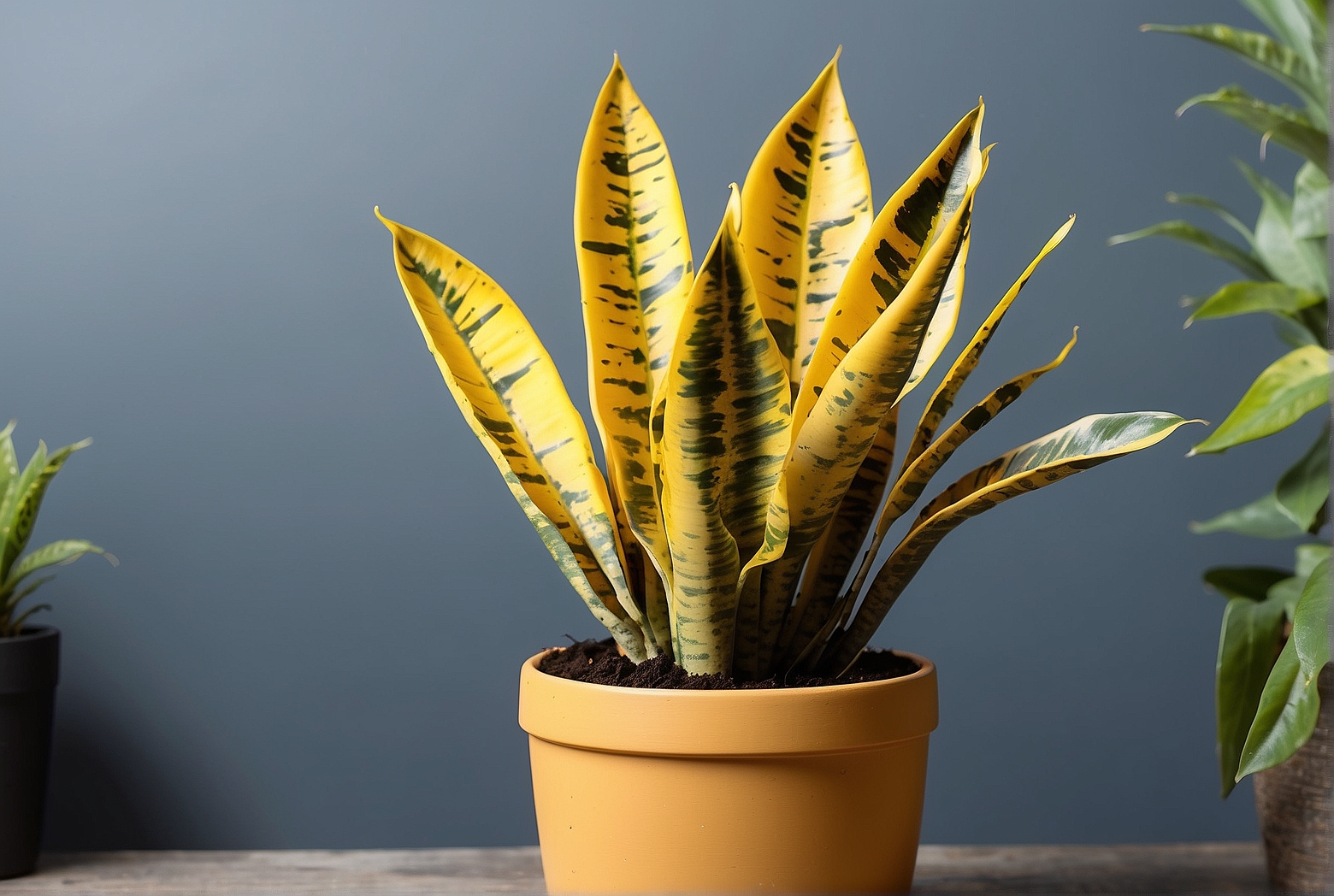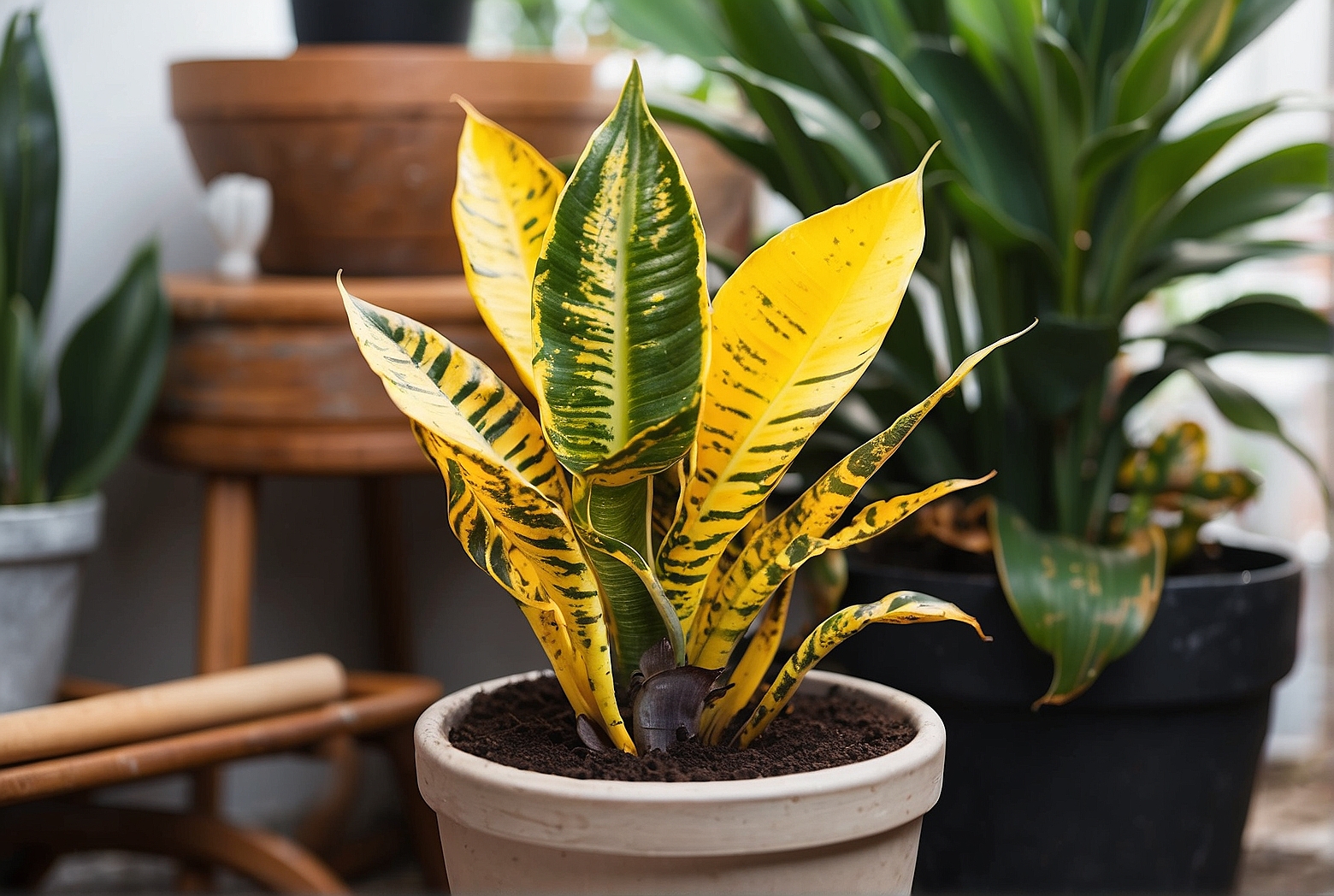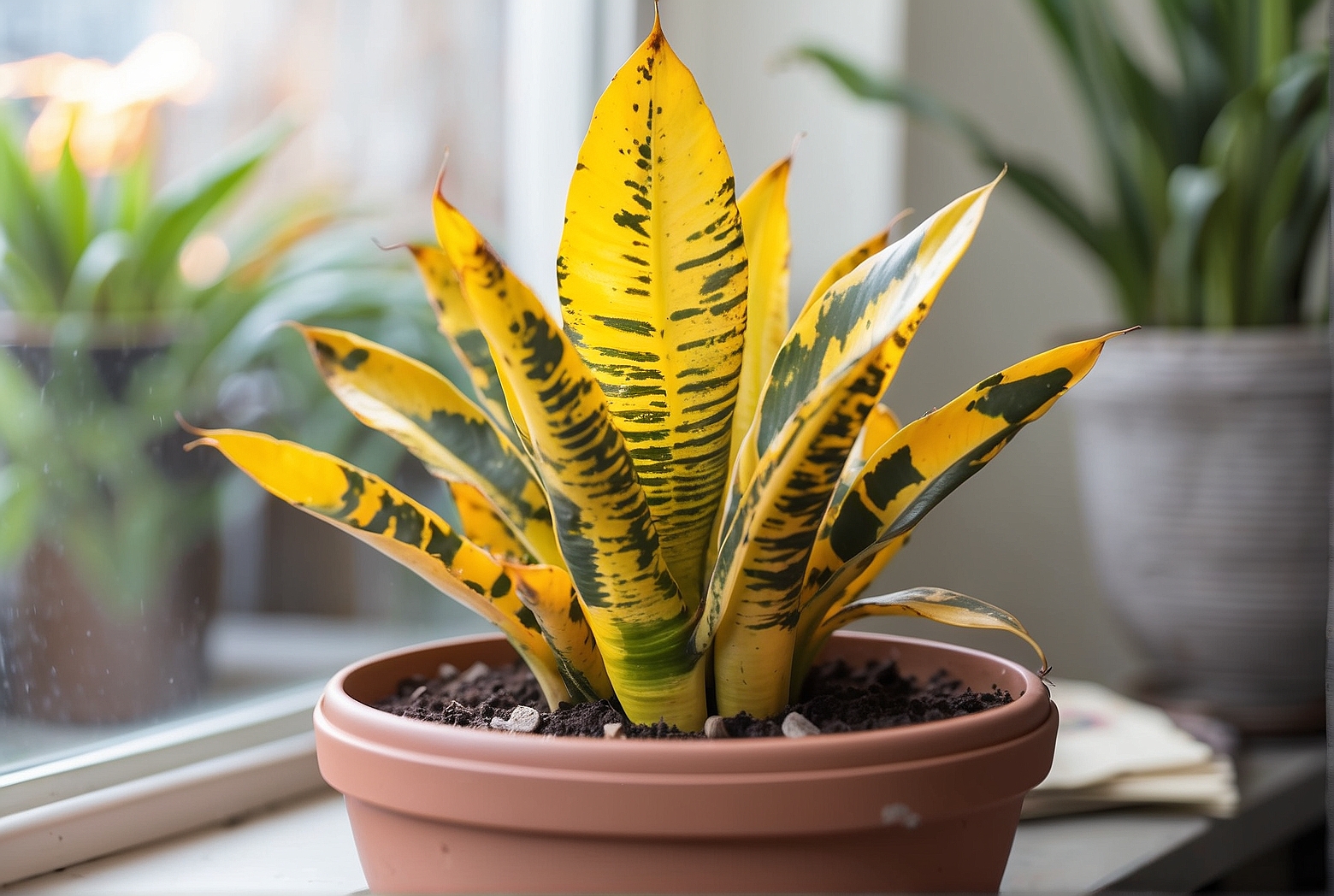Last Updated on April 14, 2024 by Tony Manhart
If you have noticed your beloved snake plant taking on a sudden yellow hue, you might find yourself wondering, “Why is my snake plant turning yellow?” Fear not, for in this article, we will explore the various factors that could be causing this alarming change in color. Whether it is due to overwatering, lack of sunlight, or even a pest infestation, we will delve into the possible reasons behind this phenomenon. By the end, you will possess the knowledge to revive your snake plant and restore its vibrant green allure.
Environmental Factors
Overwatering
Overwatering is a common mistake many plant owners make when caring for their snake plants. While it’s important to provide enough water for your plant’s growth, overwatering can lead to root rot, a condition where the roots are deprived of oxygen and become mushy and brown. To avoid overwatering, make sure the top two inches of soil are dry before watering your snake plant again.
Underwatering
On the other hand, underwatering can also cause your snake plant to turn yellow. When the soil is too dry, the plant’s leaves will begin to wilt and lose their vibrant green color. To remedy this, check the moisture level of the soil regularly and water your snake plant thoroughly when the top inch is dry. Remember, it’s better to slightly underwater than to overwater your snake plant.
Improper Lighting
Snake plants are known for their resilience and ability to thrive in a variety of lighting conditions. However, inadequate or excessive light can cause the leaves to turn yellow. If your snake plant is placed in an area with low light, such as a dark corner, it may not receive enough energy for photosynthesis, leading to yellowing leaves. On the other hand, if your plant is exposed to direct sunlight for extended periods, the leaves can become scorched and develop yellow patches. Find a balance by placing your snake plant in bright, indirect light to ensure optimal growth.

Temperature Extremes
Snake plants are native to tropical regions and prefer temperatures between 70°F to 90°F (21°C to 32°C). Exposure to extreme temperatures, either cold or hot, can cause the leaves to turn yellow. Cold drafts or placing your snake plant near air conditioning vents during winter can lead to chilling injury, resulting in yellowing leaves. Additionally, if your plant is positioned near a heat source, such as a radiator, the excessive heat can cause the foliage to become discolored. Maintaining a consistent temperature within the recommended range will help prevent yellowing.
Low Humidity
Low humidity levels can also contribute to yellowing snake plant leaves. Snake plants thrive in moderate to high humidity environments, and when the air is too dry, their leaves may start to turn yellow. This is especially common during winter when indoor heaters are running, reducing the humidity levels in your home. You can increase humidity around your snake plant by misting its leaves regularly or placing a humidifier nearby.
Pest Infestation
Spider Mites
Spider mites are tiny pests that can infest your snake plant and cause yellowing leaves. These pests are difficult to detect as they are only about the size of a pinhead, but you may notice small webs or speckled leaves if your plant is infested. Spider mites feed on the plant’s leaves, sucking out the sap and causing yellow spots. To combat spider mites, regularly inspect your snake plant for signs of infestation and use a solution of insecticidal soap or neem oil to eliminate them.
Mealybugs
Mealybugs are another common pest that can affect snake plants. They appear as small, cotton-like masses on the leaves and stems, and their feeding can lead to yellowing and stunted growth. To treat mealybug infestations, remove the affected leaves and stems, and apply an insecticidal soap or rubbing alcohol to kill off the remaining pests.

Scale Insects
Scale insects are notorious for their ability to attach themselves to plants and suck sap from the foliage, causing yellowing leaves. They appear as small bumps or scales on the leaves and stems and can be challenging to eliminate. To get rid of scale insects, use a soft brush to scrub them off or apply an insecticidal oil or soap.
Root Rot
In addition to being caused by overwatering, root rot can also occur due to a fungal infection. This infection, often caused by overly moist soil, leads to the roots rotting and eventually affecting the health of the plant. Symptoms of root rot include yellowing leaves, a foul odor, and wilting. To prevent root rot, ensure your snake plant is planted in well-draining soil, and avoid overwatering.
Nutritional Issues
Lack of Nutrients
A lack of nutrients can result in yellowing snake plant leaves. Snake plants require essential nutrients such as nitrogen, phosphorus, and potassium to maintain their green color and overall health. When the soil lacks these nutrients, the leaves may start to turn yellow. To address this issue, consider feeding your snake plant with a balanced fertilizer designed for houseplants. Follow the instructions on the fertilizer packaging to ensure proper application.
Nutrient Imbalance
An imbalance of nutrients can also cause your snake plant’s leaves to turn yellow. For example, if your plant receives an excess of one nutrient but lacks another, it can lead to nutrient deficiencies and subsequent yellowing. Testing your soil periodically can help you identify any nutrient imbalances, and accordingly adjust your fertilizer application to provide a balanced nutrient supply to your snake plant.
Container Issues
Improper Drainage
Proper drainage is crucial for snake plants to prevent water from pooling around the roots and causing root rot. If your snake plant is in a container without drainage holes or if the soil is not well-draining, excess water may accumulate, leading to yellowing leaves. To provide proper drainage, ensure that your snake plant is potted in a container with drainage holes and a well-draining soil mix.
Root Bound
A snake plant that has become root-bound may also exhibit yellowing leaves. When the plant’s roots become overcrowded in its container, they can’t access sufficient nutrients and water, resulting in yellowing and stunted growth. If you notice roots circling the inside of the pot or pushing against it, it’s time to repot your snake plant. Choose a container that is one size larger and carefully loosen the roots before replanting in fresh soil.
Disease
Fungal Infection
Fungal infections can cause yellowing leaves in snake plants. These infections commonly occur due to overwatering or high humidity, providing an ideal environment for fungi to thrive. Symptoms of a fungal infection include yellow spots or patches on the leaves, as well as wilting. To address a fungal infection, remove the affected leaves and adjust your watering practices to prevent excess moisture.
Bacterial Infection
Bacterial infections can also lead to yellowing leaves in snake plants. These infections may occur if your plant has an open wound or if it has been exposed to contaminated soil or water. Symptoms of bacterial infection include yellowing leaves with brown or black spots and a foul odor. To treat a bacterial infection, remove the affected leaves, sanitize your tools between uses, and ensure your snake plant is not overcrowded or overwatered.
Incorrect Soil
Poor Drainage
As mentioned earlier, poor drainage can lead to yellowing leaves due to waterlogged soil and root rot. Snake plants require well-draining soil that allows excess water to flow through and away from the roots. Avoid using heavy potting mixes or garden soils that may retain too much moisture. Opt for a well-draining potting mix specifically formulated for houseplants.
Nutrient Deficiencies
The soil in which your snake plant is grown plays a vital role in its overall health. If the soil lacks essential nutrients, it can result in yellowing leaves. Snake plants require a well-balanced mix that provides adequate nutrition for their growth. Consider amending your soil with organic matter or using a high-quality potting mix that contains a balanced blend of nutrients.
Transplant Shock
Root Damage
During the process of transplanting, the roots of your snake plant may sustain damage, leading to yellowing leaves. Root damage can occur due to rough handling, improper removal from the previous pot, or excessively trimming the roots. To minimize root damage, handle the plant gently during transplanting and use a clean, sharp tool to separate the roots from the old soil.
Lack of Acclimatization
When you move your snake plant to a new location with different lighting or temperature conditions, it may experience transplant shock, which can manifest as yellowing leaves. The sudden change in environment can stress the plant, affecting its ability to take up nutrients and water properly. Ease your snake plant into a new location by gradually exposing it to the new conditions over a period of time.
Age and Growth
Natural Aging Process
The natural aging process of snake plants can cause older leaves to turn yellow and die. As the plant grows and produces new leaves from the center, the older leaves on the outer edges may yellow and eventually wither. This is a normal part of the plant’s growth cycle, and as long as new leaves continue to develop, there’s no cause for concern.
Lack of Growth
If your snake plant is not experiencing new growth while the older leaves are turning yellow, it could indicate an underlying issue such as insufficient light or inadequate nutrients. Ensure that your snake plant is receiving adequate light and provide it with the necessary nutrients to encourage healthy growth.
Overfertilization
Excessive Nutrients
While snake plants require regular fertilization, overfertilization can lead to yellowing leaves. Excessive nutrients can cause a buildup of salts in the soil, leading to a condition known as fertilizer burn. Symptoms of overfertilization include yellowing or browning leaf tips and edges. To avoid overfertilizing, follow the instructions on the fertilizer packaging and adjust the frequency and amount based on your snake plant’s specific needs.
Cultural Practices
Incorrect Pruning
Pruning is an essential aspect of caring for snake plants, but incorrect pruning techniques can result in yellowing leaves. When pruning, it’s important to use clean and sharp tools to prevent the spread of disease. Additionally, avoid removing too many leaves at once, as this can stress the plant and lead to yellowing. Only remove dead or damaged leaves when necessary.
Improper Care
In general, improper care practices can contribute to yellowing snake plant leaves. This includes neglecting to water or excessively watering the plant, placing it in unsuitable lighting conditions, exposing it to extreme temperatures, or disregarding its specific nutrient requirements. By providing proper care, including regular watering, appropriate lighting, and suitable fertilization, you can help prevent yellowing leaves and maintain a healthy snake plant.
In conclusion, there are numerous factors that can contribute to your snake plant turning yellow. By understanding these potential causes, whether they be environmental factors, pest infestations, nutritional issues, container problems, diseases, soil concerns, transplant shock, age and growth, overfertilization, or cultural practices, you can identify the specific issue affecting your plant and take the necessary steps to address it. Remember to observe your snake plant closely, provide it with the right conditions, and ensure it receives proper care to maintain its vibrant green color and overall health.
Tony Manhart is a passionate gardener who has been tending to gardens for over 20 years. He takes pride in creating beautiful outdoor spaces with plants, trees, and shrubs that can thrive in any environment. He loves to share his knowledge with others and has taught classes on gardening basics and advanced techniques. He is committed to sustainability, using natural and organic methods to create and maintain gardens. He also works with local organizations to create green spaces for communities. When he’s not gardening, Tony enjoys hiking, reading, and spending time with his family.


